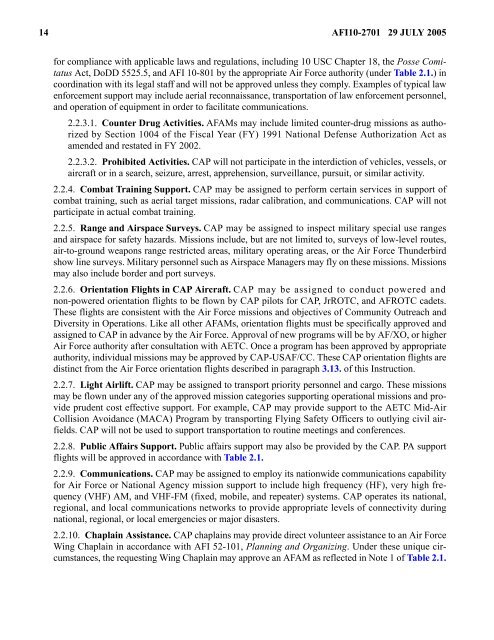AFI 10-2701 - Air Force E-Publishing
AFI 10-2701 - Air Force E-Publishing
AFI 10-2701 - Air Force E-Publishing
You also want an ePaper? Increase the reach of your titles
YUMPU automatically turns print PDFs into web optimized ePapers that Google loves.
14 <strong>AFI</strong><strong>10</strong>-<strong>2701</strong> 29 JULY 2005<br />
for compliance with applicable laws and regulations, including <strong>10</strong> USC Chapter 18, the Posse Comitatus<br />
Act, DoDD 5525.5, and <strong>AFI</strong> <strong>10</strong>-801 by the appropriate <strong>Air</strong> <strong>Force</strong> authority (under Table 2.1.) in<br />
coordination with its legal staff and will not be approved unless they comply. Examples of typical law<br />
enforcement support may include aerial reconnaissance, transportation of law enforcement personnel,<br />
and operation of equipment in order to facilitate communications.<br />
2.2.3.1. Counter Drug Activities. AFAMs may include limited counter-drug missions as authorized<br />
by Section <strong>10</strong>04 of the Fiscal Year (FY) 1991 National Defense Authorization Act as<br />
amended and restated in FY 2002.<br />
2.2.3.2. Prohibited Activities. CAP will not participate in the interdiction of vehicles, vessels, or<br />
aircraft or in a search, seizure, arrest, apprehension, surveillance, pursuit, or similar activity.<br />
2.2.4. Combat Training Support. CAP may be assigned to perform certain services in support of<br />
combat training, such as aerial target missions, radar calibration, and communications. CAP will not<br />
participate in actual combat training.<br />
2.2.5. Range and <strong>Air</strong>space Surveys. CAP may be assigned to inspect military special use ranges<br />
and airspace for safety hazards. Missions include, but are not limited to, surveys of low-level routes,<br />
air-to-ground weapons range restricted areas, military operating areas, or the <strong>Air</strong> <strong>Force</strong> Thunderbird<br />
show line surveys. Military personnel such as <strong>Air</strong>space Managers may fly on these missions. Missions<br />
may also include border and port surveys.<br />
2.2.6. Orientation Flights in CAP <strong>Air</strong>craft. CAP may be assigned to conduct powered and<br />
non-powered orientation flights to be flown by CAP pilots for CAP, JrROTC, and AFROTC cadets.<br />
These flights are consistent with the <strong>Air</strong> <strong>Force</strong> missions and objectives of Community Outreach and<br />
Diversity in Operations. Like all other AFAMs, orientation flights must be specifically approved and<br />
assigned to CAP in advance by the <strong>Air</strong> <strong>Force</strong>. Approval of new programs will be by AF/XO, or higher<br />
<strong>Air</strong> <strong>Force</strong> authority after consultation with AETC. Once a program has been approved by appropriate<br />
authority, individual missions may be approved by CAP-USAF/CC. These CAP orientation flights are<br />
distinct from the <strong>Air</strong> <strong>Force</strong> orientation flights described in paragraph 3.13. of this Instruction.<br />
2.2.7. Light <strong>Air</strong>lift. CAP may be assigned to transport priority personnel and cargo. These missions<br />
may be flown under any of the approved mission categories supporting operational missions and provide<br />
prudent cost effective support. For example, CAP may provide support to the AETC Mid-<strong>Air</strong><br />
Collision Avoidance (MACA) Program by transporting Flying Safety Officers to outlying civil airfields.<br />
CAP will not be used to support transportation to routine meetings and conferences.<br />
2.2.8. Public Affairs Support. Public affairs support may also be provided by the CAP. PA support<br />
flights will be approved in accordance with Table 2.1.<br />
2.2.9. Communications. CAP may be assigned to employ its nationwide communications capability<br />
for <strong>Air</strong> <strong>Force</strong> or National Agency mission support to include high frequency (HF), very high frequency<br />
(VHF) AM, and VHF-FM (fixed, mobile, and repeater) systems. CAP operates its national,<br />
regional, and local communications networks to provide appropriate levels of connectivity during<br />
national, regional, or local emergencies or major disasters.<br />
2.2.<strong>10</strong>. Chaplain Assistance. CAP chaplains may provide direct volunteer assistance to an <strong>Air</strong> <strong>Force</strong><br />
Wing Chaplain in accordance with <strong>AFI</strong> 52-<strong>10</strong>1, Planning and Organizing. Under these unique circumstances,<br />
the requesting Wing Chaplain may approve an AFAM as reflected in Note 1 of Table 2.1.
















